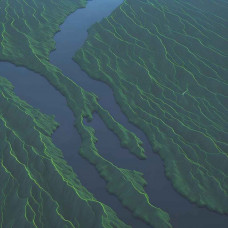An area of the earth's surface occupied by the main river and all its tributaries, from which surface and ground water flows into these watercourses.
The catchment area of each water body consists of a surface catchment and a groundwater catchment. The surface catchment is the part of the land surface from which water flows into a particular river system or river. The subterranean catchment consists of layers of loose sediment from which water enters the river system. In general, the surface catchment and the groundwater catchment do not coincide. However, as it is very difficult in practice to determine the boundaries of the groundwater catchment, only the surface catchment is taken as the value of the river basin.
Errors in the conventional determination of catchment area and surface area may only be significant for small rivers and lakes and for larger rivers flowing in geological conditions that ensure good water exchange between neighbouring basins. The boundary between the basins of individual water bodies runs along watersheds.
Basins are divided into drained and un-drained basins. Drainless basins are areas of inland flow that are not connected to the ocean by river basins. The shapes and sizes of basins vary greatly, depending on the geographical location, topography and geology of the area. River tributaries have their own small basins, which together make up the catchment area of the main river.
River basin
Tags: River basin


